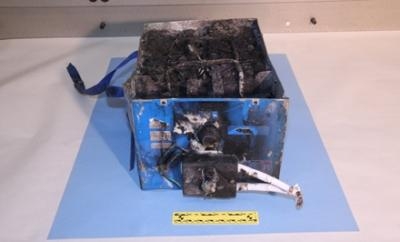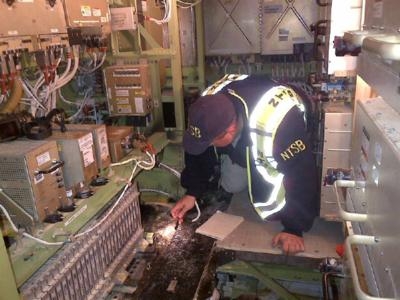Fri, Jan 18, 2013
Two Recent Incidents Now Appear Different In Nature
Quoting sources that would speak only on the condition of anonymity, the Seattle Times is reporting that hot chemicals sprayed out of the battery on the 787 Dreamliner that made an emergency landing in Japan on Wednesday. The result was a gooey dark residue left behind that suggests a different malfunction than last week's battery fire in a 787 at Boston's Logan International Airport.

While there was no fire in the most recent incident one of the Times' sources said "It's still a problem. There was significant overheating."
The more significant problem may become the emerging reports that Boeing was warned about the safety of the batteries and associated systems as early as 2006. Those reports center on the actions of whistleblower Michael Leon.
Aviation reporter and blogger Ben Sandilands writes in Plane Talking that while employed at Securaplane, which brought together mission critical battery assemblies for the 787, Leon wrote a report on the battery technology planned for the 787 saying it was a flight of safety risk and that substitute battery technology should be used. A month later, Securaplane's main buildings were burned to the ground when a battery test went wrong. Leon was injured in the blaze. Securaplane reportedly tried to force Leon out of the company when he refused to ship what he considered an unsafe battery assembly to Boeing for use in the 787. That assembly later malfunctioned when installed in a prototype airframe.
There are four circuits that control the batteries in question, two within the battery and two external. Boeing says it believes those circuits performed as designed and stopped the overheating before any fire could start. Additionally Boeing says tests show that any smoke from the incident should have vented overboard through outflow valves and not entered either the passenger cabin or cockpit. But ANA (All Nippon Airways) said its pilots did smell something they thought was smoke and that the smell was also in the passenger cabin. The FAA, in announcing its decision to ground the fleet said in its statement that both battery incidents resulted in the "release of flammable electrolytes, heat damage, and smoke."

It was that smell and warnings of battery trouble on the instrument panel that compelled the ANA pilot to execute the emergency landing and deploy the emergency exit chutes to evacuate the 137 passengers and crew.
The Times reports that two people with knowledge of the incident said the pilot received three battery warnings, including one that said the battery was overheating.
The 787s batteries are made by GS Yuasa of Japan and its manufacturing process is almost certainly gong to become part of the investigation.
(Images provided by the NTSB)
More News
Klyde Wonders If The 'New' SouthWest Can 'Out-Spirit' Spirit... FMI: www.klydemorris.com>[...]
From 2012 (YouTube Edition): Extensive Expertise in Backup Solutions Makes MCIA Uniquely Qualified In This Market There's no such thing, in aviation, as TOO much caution... hence t>[...]
Aero Linx: Historic Aircraft Association (HAA) The Historic Aircraft Association (HAA) was founded in 1979 with the aim of furthering the safe flying of historic aircraft in the UK>[...]
Jamming Denotes emissions that do not mimic Global Navigation Satellite System (GNSS) signals (e.g., GPS and WAAS), but rather interfere with the civil receiver's ability to acquir>[...]
"Respectfully, U.S. and European airlines should not be even contemplating the future purchase of airplanes from Chinese military companies...” Source: US Representative Raja>[...]
 Klyde Morris (05.02.25)
Klyde Morris (05.02.25) Classic Aero-TV: Introducing The MD302--Mid-Continent's Standby Attitude Module
Classic Aero-TV: Introducing The MD302--Mid-Continent's Standby Attitude Module ANN's Daily Aero-Linx (05.04.25)
ANN's Daily Aero-Linx (05.04.25) ANN's Daily Aero-Term (05.04.25): Jamming
ANN's Daily Aero-Term (05.04.25): Jamming Aero-News: Quote of the Day (05.04.25)
Aero-News: Quote of the Day (05.04.25)




